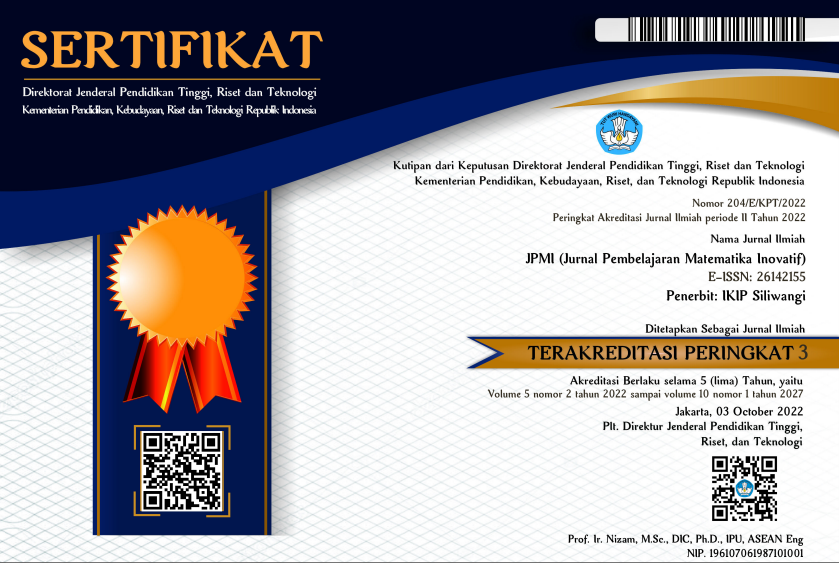Meningkatkan kemampuan pemecahan masalah matematis terhadap pendekatan realistic mathematics eduction (RME) berbantuan VBA excel
DOI:
https://doi.org/10.22460/jpmi.v8i1.24963Kata Kunci:
Problem Solving Skills, Realistic Mathematics Eduction (RME), Visual Basic for Applications (VBA) ExcelAbstrak
This research aims to examine the enhancement of mathematical problem-solving skills and the application of learning through the RME approach with the assistance of VBA Excel. The method used in this research is a quasi-experimental design with a pretest-posttest control group involving two groups of students: the experimental group, which received treatment through the RME approach assisted by VBA Excel, with the outcome observed being the students' mathematical problem-solving abilities. Meanwhile, the control group received instruction using the conventional approach. The population in this study is all eighth-grade students at SMP Negeri 4 Cimahi. The research sample consists of two randomly selected classes, namely the experimental class with 30 students and the control class with 30 students at SMPN 4 Cimahi. The instrument used consists of four open-ended questions assessing mathematical problem-solving abilities on the topic of the Pythagorean theorem. Data analysis was conducted using normality tests, homogeneity tests, and t-tests. The research results indicate that the Realistic Mathematics Education (RME) approach assisted by VBA Excel can enhance students' mathematical problem-solving abilities compared to the conventional approach in the learning process.
Referensi
Fauzan, A., & Yerizon, Y. (2013). Pengaruh pendekatan RME dan kemandirian belajar terhadap kemamampuan matematis siswa. Prosiding SEMIRATA 2013, 1(1). https://www.academia.edu/download/62961250/699-1538-1-SM.pdf
Fitri, E. M., Masjudin, M., & Febrilia, B. R. A. (2024). Pengaruh pembelajaran matematika dengan VBA excel terhadap motivasi dan hasil belajar siswa MTS Tarbiyatul Qurra’ tahun 2022/2023. Jurnal Kependidikan Ki Hajar Dewantara, 1(1), 15–25. https://permatamandalika.com/index.php/khd/article/view/11
Hendriana, H., Rohaeti, E. E., & Sumarmo, U. (2017). Hard skills dan soft skills matematik siswa. Bandung: Refika Aditama.
Hodiyanto, H. (2017). Hubungan kemampuan pemecahan masalah matematis dan kemampuan koneksi matematis dengan prestasi belajar mahasiswa. Jurnal Pendidikan Informatika Dan Sains, 6(2), 208–218. https://doi.org/https://journal.ikippgriptk.ac.id/index.php/saintek/article/view/645
Novianti, V., Sa’adah, N., & Chotimah, S. (2019). Pengaruh penggunaan media pembelajaran berbasis VBA for excel terhadap motivasi siswa SD pada materi bangun datar. Journal on Education, 2(1), 110–116. https://doi.org/10.31004/joe.v2i1.280
Noviyana, H dan Fitriani, D. (2018). Pengaruh model realistic mathematics education (RME) terhadap kemampuan pemecahan masalah matematis siswa kelas VIII SMP. Prosiding Sesiomadika, 2(1c), 829. https://journal.unsika.ac.id/index.php/sesiomadika/article/view/2511
Nugraha, M. R., & Basuki, B. (2021). Kesulitan kemampuan pemecahan masalah matematis siswa SMP di desa mulyasari pada materi statistika. Plusminus: Jurnal Pendidikan Matematika, 1(2), 235–248. https://journal.institutpendidikan.ac.id/index.php/plusminus/article/view/898
Pebriyanti, A., Bernard, M., & Afrilianto, M. (2023). Analisis kemampuan Berpikir kritis matematis siswa SMP kelas VII berbantuan visual basic application for excel pada materi pecahan. Jurnal Pembelajaran Matematika Inovatif, 6(1), 55–64. https://doi.org/10.22460/jpmi.v6i1.10783
Rahman, Z. H., & Setyaningsih, R. (2022a). Meningkatkan kemampuan pemecahan masalah siswa melalui pendekatan realistic mathematics education. AKSIOMA: Jurnal Program Studi Pendidikan Matematika, 11(2), 1620. https://doi.org/10.24127/ajpm.v11i2.5139
Rahman, Z. H., & Setyaningsih, R. (2022b). Meningkatkan kemampuan pemecahan masalah siswa melalui pendekatan realistic mathematics education. AKSIOMA: Jurnal Program Studi Pendidikan Matematika, 5(3), 248–253. https://doi.org/10.24127/ajpm.v11i2.5139
Rulyansah, A. (2021). Integrasi realistic mathematics education dan multiple intelligences pada siswa sekolah dasar. ELSE (Elementary School Education Journal): Jurnal Pendidikan Dan Pembelajaran Sekolah Dasar, 5(1), 45–54. https://doi.org/http://dx.doi.org/10.30651/else.v5i1.7336
Shadiq, F. (2004). Penalaran, pemecahan masalah dan komunikasi dalam pembelajaran matematika. Yogyakarta: PPPG Matematika.
Sumartini, T. S. (2016). Peningkatan kemampuan pemecahan masalah matematis siswa melalui pembelajaran berbasis masalah. Mosharafa: Jurnal Pendidikan Matematika, 5(2), 148–158. https://journal.institutpendidikan.ac.id/index.php/mosharafa/article/view/391
Susanti, S. (2017). Meningkatkan kemampuan pemecahan masalah matematis dan self-efficacy siswa MTs melalui pendekatan pendidikan matematika realistik. Suska Journal of Mathematics Education, 3(2), 92. https://doi.org/10.24014/sjme.v3i2.4148
Susilowati, E. (2018). Peningkatan aktivitas dan hasil belajar matematika siswa SD melalui model realistic mathematic education (RME) pada siswa kelas IV semester I di SD negeri 4 kradenan kecamatan kradenan kabupaten grobogan tahun pelajaran 2017/2018. PINUS: Jurnal Penelitian Inovasi Pembelajaran, 4(1), 44–53. http://ojs.unpkediri.ac.id/index.php/pinus/article/view/12494
Tantra, S. A. M., Widodo, S., & Katminingsih, Y. (2022). Peningkatan kemampuan pemecahan masalah matematis peserta didik melalui pembelajaran Realistic Mathematics Education (RME). UNEJ E-Proceeding, 587–600. https://jurnal.unej.ac.id/index.php/prosiding/article/view/33556
Utami, S. (2017). Pengaruh model pembelajaran flipped classroom tipe peer instruction flipped terhadap kemampuan pemecahan masalah matematik siswa. Fakultas Ilmu Tarbiyah Dan Keguruan. http://repository.uinjkt.ac.id/dspace/handle/123456789/34720
Widana, I. W. (2021). Realistic mathematics education (RME) untuk meningkatkan kemampuan pemecahan masalah matematis siswa di Indonesia. Jurnal Elemen, 7(2), 450–462. https://doi.org/10.29408/jel.v7i2.3744
Unduhan
Diterbitkan
Terbitan
Bagian
Lisensi

Artikel ini berlisensiCreative Commons Attribution-ShareAlike 4.0 International License.
The author is responsible for acquiring the permission(s) to reproduce any copyrighted figures, tables, data, or text that are being used in the submitted paper. Authors should note that text quotations of more than 250 words from a published or copyrighted work will require grant of permission from the original publisher to reprint. The written permission letter(s) must be submitted together with the manuscript.
















